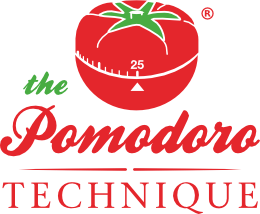The Pomodoro Technique
Posted on Mon 18 January 2010 in Productivity

I bought a book, basically because it was a GTD technique that came off the pragmatic bookshelf so I figured I'd give it a shot.
Explanation:
To give a very brief explanation of the technique. You have a sheet with Today's Todos, each time you do 25 minutes of work towards your todos you mark a 'pomodoro' and take a 5 minute break. You then clock up pomodoros everyday.
Then every morning you pick from your \\activity inventory\\(an unsorted list of todos), and pick the highest priority tasks, beside each task should be an estimate of how many pomodoros it should take. For exampleI had estimated 2pomdoros for this blog post. So when selecting your pomodoros for the day you take your pomodoro average (sum of all the pomodoros you've ever done divided by the number of days), and don't add more estimated pomodoros than your averages. So for example my average could be 11 and I could have 3 high priority tasks each estimated to take 5 pomodoros each, well clearly I would have to add 2 and find a third that only took 1 pomodoro.
Now clearly there's more to it(they have managed to get several books out of it). What you log all metrics on is called a report sheet, so things I log are completed pomodoros, how far off my estimates were, how many tasks did I fail to do today etc.
How I use it
I fully commited to the technique both at home and at work. So in work I have a large diary and some extra sheets, for my 'personal' stuff I use a small moleskine diary to do the job. There have been dramatic results on both accounts. In work I noticed a better structure coming around my day. When people asked me for things I now always delay till I've finished my pomodoro(the book explains how to handle interruptions), then weight how important the new task was over what I'm currently working on. I also find myself looking back very satisfied with the work I've done for the day, a personal sense of accomplishment. On top of that I like the fact if anyone did ask 'what did you do all last week?', I could very easily give a breakdown on what tasks I was working on.
Like everything else discipline is key. I've even noticed myself slipping the odd time. Say I finish a task in 20 minutes, the technique calls for 25 minutes of focused work, so you should now focus on how you could do the task better or just improve on the task in some way. This is fine depending on some tasks but some just can't be done any better. Going to the bathroom also becomes an interesting game as if you need to go to the bathroom you should cancel the pomodoro, very annoying when your bursting to go 22 minutes in. But youdo begin to relish maintaining an average of sorts. It's something you work towards and try increase.
It's flexible!
Now however a problem has become apparent and this is where the flexibility of the technique comes in. As a programmer I noticed a 'flow' that stops as soon as the timer does(that's the point), I've noticed 25 minutes is not nearly enough time so, as a compromise I can now alter how my pomodoro works. For this week I'm going to try 2*25 minute programming pomodoros followed by a ten minute break. I could increase the time of the pomodoro itself (say 25 to 50 minutes) but I'd rather keep it 25 (busy work such as replying to emails etc doesn't take 50 minutes).
Kaizen
In essence the point of the technique is not the 25 minute burst is actually something called Kaizen, meaning make small improvements everyday. The constant reviewing of priorities and the daily review of work done is the real value in this technique. I find measuring metrics on your own productivity very powerful. If I find I'm doing more with 2*25 minute pomodoros, maybe I'll try 4 and take a 20 minute break.
To be honest I've actually found more use for this technique at home than at work. With work there is structure to your day and deadlines looming that will always motivate you. At home that project or that programming language that you've wanted to do for months has no deadlines and just doesn't magically get done. With my moleskine(and calendar reminders) I've got a constantmotivator to get things done and do them better next time.
I can recommend this technique for anyone. To get started all it takes is 3 sheets of paper(the activity inventory, the report sheet and today's todos) and some willpower. The book itself is great and would highly recommend a purchase.
Resources
A decent Online Cheatsheet.
A free book written by the inventor of pomodoro(not the prag prog one I've read)
A mindmap I've done.
This one may read very strangely and how I do the technique may not work for you, but the hats represent a different 'focus' and when my productivity starts to wane imagining the hats works well. I would suggest using the mindmap after reading the prag programmer book.
Enjoy!